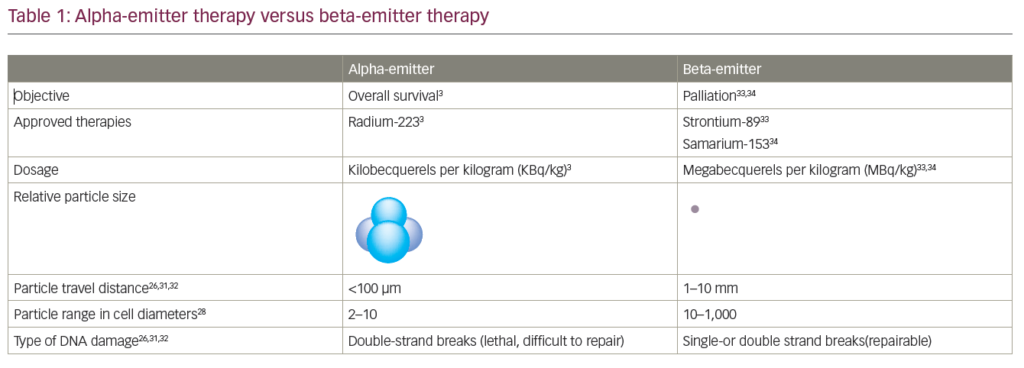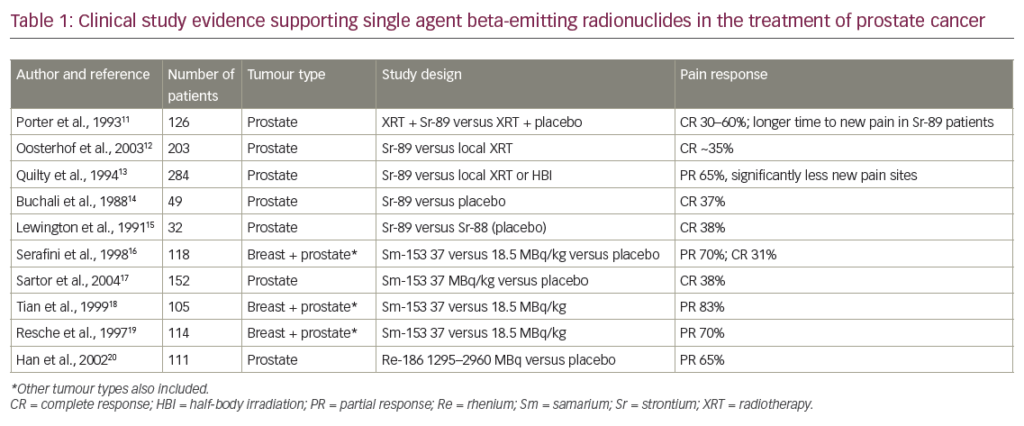The combination of external beam radiotherapy (EBRT) with brachytherapy boost has become a common treatment approach for prostate cancer patients over the past 15 years.The concept of prostate brachytherapy was first introduced in the early 20th century at Johns Hopkins Hospital under the tutelage of Hugh Hampton Young with the use of transurethral sources for treatment. Unfavorable dosimetric constraints and resultant high rates of complications led to the abandonment of this approach in favor of radical prostatectomy. Subsequently, a retropubic approach under direct visualization was pioneered at the Memorial Sloan-Kettering Cancer Center in New York in the 1960s and 1970s. Unfavorable dosimetry again led to abandonment of this technique.1,2 The use of transrectal ultrasound (TRUS) guidance for permanent prostate brachytherapy was developed in Denmark and first reported by Holm et al. in 1983.3 The technique was further modified by Blasko et al. and introduced as a treatment option in the US in 1987.4 The use of stereoscopic needle placement under realtime ultrasound imaging greatly improved the reliability of needle placement and subsequent radioactive seed distribution. High dose rate (HDR) temporary brachytherapy with Iridium (Ir)-192 has also become increasingly popular with promising efficacy results reported.5,6 The scope of this article focuses on the more widely used permanent low-dose rate brachytherapy performed with either Iodine (I)125 or Palladium (Pd)103.
Brachytherapy is the ultimate conformal radiation technique allowing for high-dose delivery within the prostate with sharp dose fall-off to surrounding structures. The ability to deliver an ablating dose of radiation is evidenced by the report of magnetic resonance spectroscopic imaging (MRSI) metabolic profiles by researchers at University of California San Francisco (UCSF), which demonstrated universal lack of metabolic activity in the prostate by four years post-implant.7 While brachytherapy alone is an excellent method for delivering a high dose to the prostate, for patients at risk of extra-capsular extension the combination of external beam to provide a wider uniform dose margin to the prostate, seminal vesicles, and pelvis at times, combined with brachytherapy boost, has become an widely accepted therapeutic strategy for men with intermediate- to high-risk prognostic factors commonly defined by clinical stage, prostate-specific antigen (PSA), and Gleason score.
Published literature supporting the use of external beam radiotherapy (EBRT) and brachytherapy boost to date is based on single institution retrospective data.8–13 Sylvester et al. reported the Seattle experience with 10-year biochemical relapse-free survival (BRFS) for 232 patients. Patients were treated with 45Gy EBRT followed by brachytherapy boost with either I125 (120Gy) or Pd103 (108Gy). No patients underwent androgen ablation. Biochemical failure was defined as two consecutive rises in PSA.With a median follow-up of 63 months, 10-year BRFS was 86%, 90%, and 48% for low, intermediate, and high-risk groups defined by the D’Amico risk stratification criteria.8 Dattoli et al. reported a series with 163 patients with clinical T1-T3 prostate cancer with Gleason score ≥7 and/or PSA >10ng/ml who underwent EBRT to 41Gy followed by an 80Gy Pd103 boost. One hundred and thirty patients whose pathology specimens were available for central review were included in the analysis.The authors noted a median follow-up for non-failing patients of seven years with 118 patients followed for longer than five years. The actuarial rate of freedom from biochemical progression, defined as PSA ≤2ng/ml at time of last follow-up,was 79%.9
Others have reported promising results with shorter follow-up. Merrick reported five-year actuarial biochemical freedom from failure of 80% in 65 patients treated with combined therapy, with high-risk disease defined as having two or three risk factors including Gleason score ≥7, PSA ≥10ng/ml, and clinical stage ≥T2b.10 Singh et al. performed a matched-pair analysis of combined therapy compared with EBRT alone with 80 patients per treatment group. Five-year biochemical failure free survival was 86% for combined therapy compared with 72% with external beam to a minimum planning target dose of 70.2Gy. It was noted that 80% of patients received androgen deprivation.11 Copp et al. reported a 79% rate of freedom from biochemical failure at four years in 93 intermediate- to high-risk patients treated with EBRT, brachytherapy, and androgen suppression.12 Critz et al. reported results using an approach with upfront brachytherapy, with I125 to a median dose of 120Gy followed three weeks later by a six-week course of EBRT for an additional 45Gy. Patients with Gleason ≥7, PSA ≥10ng/ml, or prostatic base involvement received an additional 7.5Gy boost to the prostate and seminal vesicles.With a median follow-up of four years in 689 patients with clinical T1–T2 disease, they reported a five-year biochemical relapse-free survival of 88% as defined by maintenance of a PSA nadir of 0.2ng/ml or less.9 The median pre-treatment PSA was 7.5ng/ml. Extrapolation of these results to other series is made difficult by stratification of patients only by PSA and therefore inclusion of many patients typically stratified as low-risk. With the potential for added toxicity with combined treatment and similar biochemical results reported for brachytherapy alone in low-risk patients, the routine use of combined therapy in the low-risk population appears unwarranted. For patients with adverse risk factors, combined EBRT and brachytherapy with consideration for the addition of androgen deprivation is supported by published results to date.
In addition to tumor eradication, an important consideration for men contemplating treatment choices is quality of life post-treatment.The published data to date suggests an acceptable side effect profile with combined therapy, albeit with some suggestion of significant acute and long-term toxicity at times.14–20 As expected, the principal toxicities experienced by patients undergoing combined therapy are related to urinary, bowel, and sexual function. Sexual function may be affected to a greater degree with combined therapy as opposed to brachytherapy alone, as suggested by an analysis of the CaPSURE™ database utilizing validated quality of life instruments.14 Apart from sexual side effects, a review of the literature reveals the most commonly noted toxicities to include urinary obstructive symptoms, frequency, and dysuria. Typically, symptoms peak in the first several months following therapy with return to or close to baseline in most patients within one to two years. Increased rates of rectal bleeding, compared with EBRT or brachytherapy alone, attributable to the high dose received by the anterior rectal wall, has been noted in at least one reported series.15 Fortunately, severe rectal toxicities including fistulas or the need for colostomy are very rare when the procedure is performed by experienced physicians.
Despite the growing popularity of combined EBRT and brachytherapy boost for men with adverse risk factors, there are no completed phase III trials comparing this approach with other commonly used prostate cancer treatments to date. Currently, a phase III trial, is being conducted by the Radiation Therapy Oncology Group (RTOG 0232) comparing the use of brachytherapy alone with external beam and brachytherapy. Eligible patients have intermediate risk prostate cancer as defined by clinical T1b–T2b with either a Gleason score of seven and a PSA of less than 10 or a Gleason score of less than seven and a PSA of 10–20. Typical of eligibility criteria in common use, a prostate gland size of >60cc, prior history of transurethral resection of the prostate (TURP), or similar procedures for benign prostatic hyperplasia (BPH) and American Urological Association (AUA) symptom index score of more than 15 are excluded. Patients are randomized to either brachytherapy alone to a dose of 145Gy with I125 or 120Gy with Pd103 compared with 45Gy EBRT followed by either 110Gy or 100Gy boost with I125 or Pd103, respectively.
Two phase II cooperative group studies assessing feasibility, toxicity, and with longer follow-up treatment efficacy of combined EBRT and brachytherapy have been completed in the US. Prior to initiation of the RTOG phase III trial, a phase II trial was completed by the RTOG with the primary end-point of verifying acceptable rates of long-term grade III toxicity. Patients received 45Gy EBRT to the prostate and seminal vesicles followed two to six weeks later by a boost of 108Gy with I125.Twenty-seven per cent of patients received androgen suppression, which was left to the decision of the treating physicians. One hundred and thirty-eight patients were enrolled. Acute grade 3 toxicity occurred in 7.6% of patients and the rate of grade III long-term toxicity at 18 months was 3.3%. No grade 4 or 5 toxicity occurred.21 The findings were noted to be consistent with prior single institution reports supporting the safety profile of combined therapy.The Cancer and Leukemia Group B has also recently completed a phase II feasibility trial of combined EBRT and brachytherapy for intermediate risk patients.All patients received androgen suppression for six months combined with 45Gy EBRT and 100Gy (I125) or 90Gy (Pd103) brachytherapy boost performed two to four weeks after completion of EBRT. A total of 63 patients were enrolled on the Cancer and Leukemia Group B (CALGB) trial with a preliminary report on toxicity anticipated in 2006. With additional follow-up, both of these cooperative group phase II trials will provide assessment of treatment efficacy.
The combination of EBRT with brachytherapy boost for the treatment of men with adverse-risk, clinically localized disease is an attractive strategy to ensure regional coverage while providing a high radiation dose to the prostate. Single institutional retrospective data support the hypothesis that excellent results can be achieved with acceptable toxicity. Mature analyses of now completed cooperative group phase II studies and the on-going phase III RTOG study will provide further clarification of the role of this innovative treatment strategy in the management of prostate cancer.■
My Learning
Login
Sign Up FREE
Register Register
Login
Trending Topic

12 mins
Trending Topic
Developed by Touch
Mark CompleteCompleted
BookmarkBookmarked
Allan A Lima Pereira, Gabriel Lenz, Tiago Biachi de Castria
NEW
Despite being considered a rare type of malignancy, constituting only 3% of all gastrointestinal cancers, the incidence of biliary tract cancers (BTCs) has been increasing worldwide in recent years, with about 20,000 new cases annually only in the USA.1–3 These cancers arise from the biliary epithelium of the small ducts in the periphery of the liver […]
touchREVIEWS in Oncology & Haematology. 2025;21(1):Online ahead of journal publication














